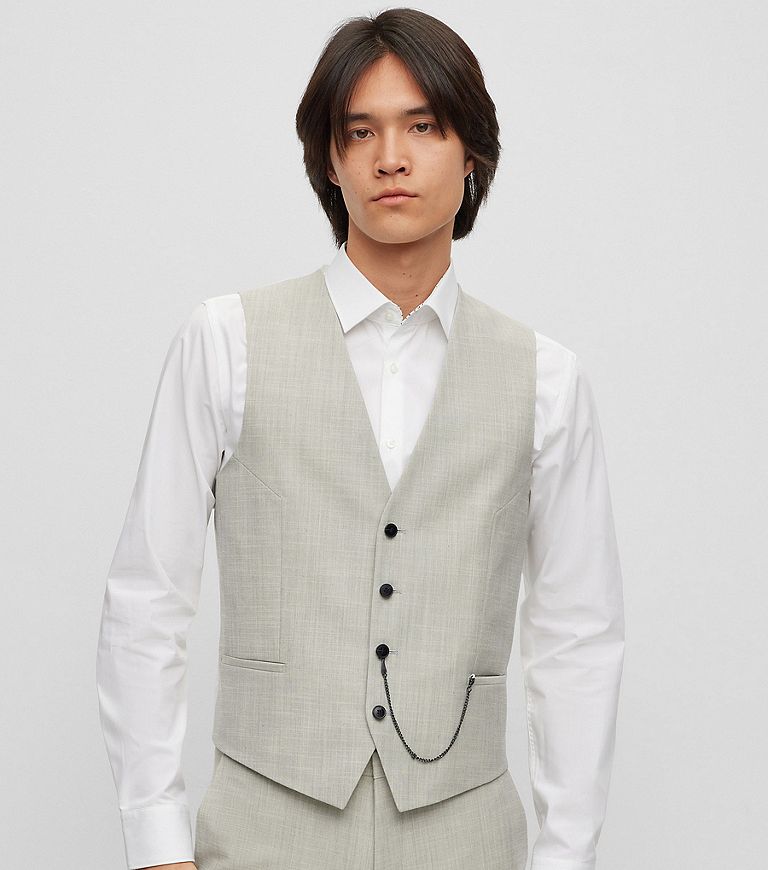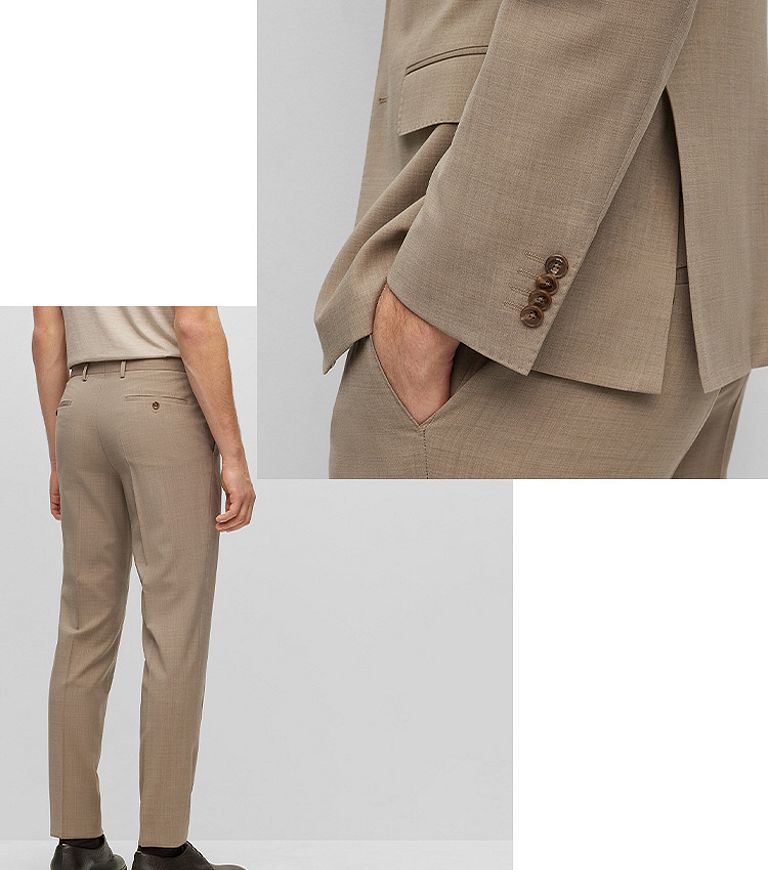News from BOSS and HUGO
To receive newsletters and exclusive offers, customize your settings in MY PREFERENCES.
A suit will never go out of style. Or more appropriately, a great-fitting suit will never go out of style. So follow these helpful guidelines (with some input from the experts) when considering the different elements of your chosen tailoring, and rest assured your suit will keep you feeling confident, each and every time you wear it.
The suit jacket
MAKE SURE YOUR JACKET IS LONG ENOUGH
“The current trend for softer and more fluid tailoring means cloth with more movement and drape. This lends itself to a longer-line jacket – something that falls just below the hip – which works better for deconstructed, lightweight shapes meant to be worn undone,” advises Catherine Hayward, fashion director of Esquire UK. “The extra-short ‘bumfreezer’ style is currently on hiatus, so elegantly louche is the attitude to aim for.”
KEEP A STRAIGHT SLEEVE LINE
“The seam on the shoulder of a deconstructed jacket should sit just at the point at which the shoulder curves over into the arm. If your jacket has a lot of construction and padding around the shoulder, it should hang over by no more than 1cm, and the line of the sleeve down from the nape of the shoulder should be straight,” shares Teo van den Broeke, style and grooming director at British GQ. “Ergo, the curve of your bicep should never be visible through your jacket. Ever.”
ALIGN YOUR JACKET AND SHIRT COLLARS
Fit is everything in a jacket, and the collar is where you want to pay particular attention. Make sure the jacket collar rests neatly against the shirt collar, touching it only lightly and with no large gaps in between. Where the collar turns to lapel, Teo van den Broeke shares some styling advice: “Lapel-wise, ultra-wide is having a moment, but this isn’t for everyone. If you’re looking to make a statement, a 90s-style mandarin or Nehru-collared jacket has a low-key, summery appeal.”
BUTTON YOUR JACKET CORRECTLY
Your approach to buttoning your jacket should differ depending on whether it is single- or double-breasted. “Beautifully cut, buttoned-up double-breasted jackets work particularly well on long, lean frames, draping the form and creating an illusion of shape,” explains Teo van den Broeke. “I’m also a fan of single-breasted jackets, but only when the fabric of the suit is relatively thick, as this will afford the suit a more elegant construction.” Remember to keep the last button of a single-breasted jacket open to avoid a taut ‘X’ shape.
SHOW A LITTLE SHIRT
Approach your suit sleeve with the intention of showing a flash of shirt cuff – though no more than 1-2 cm. To achieve this, measure your suit sleeve to hit just above where your cuff meets your wrist, making sure it doesn’t overhang or fall too long.
the suit trouser
WEAR YOUR TROUSERS HIGH ENOUGH
Make sure your trousers fit at the high hipbone, too low will come off as sloppy. Catherine Hayward advises that “Sportswear’s huge impact on tailoring means a lot of suit trousers currently resemble trackpants – complete with elasticated waist, hem and drawstring. Fine for a casual workplace, but for a more formal, elegant silhouette, far better to choose trousers with a slightly wider waistband and a single or double pleat for ease of movement around the thigh, and shorter-cuffed trousers that show some ankle.”
GET YOUR TROUSER BREAK RIGHT
It’s all about the break – which is simply the point at which your trouser touches your shoe, a position open to interpretation depending on your personal style. We recommend that trousers with a cuff be tapered for a modern look, with very little break so that they hover ever-so-slightly over the shoe and show off the sock. For more formal tailoring with a clean hem, the classic approach would be a medium break, where the trouser leg slightly pools over the shoe. Note that with a clean hem, you want the trouser leg to fall slightly longer in the back than the front. For formal occasions, a half-break is the traditional strategy for a fuller look.
the details
DARE TO ADD A WAISTCOAT
The three-piece suit is a statement of confidence. Your waistcoat should hang just above your belt or a touch longer, and should lie flat and narrow at your waist – no flapping sides or gaping holes. Waistcoats are best worn buttoned-up, not loose, to give some shape, but the last button can remain open for a bit more ease.
GET RID OF EXTRA STITCHING
Remove all superfluous stitching when you take your suit home – these were once the tailor’s trusted guidelines, but they’re no longer needed. Pockets, however, do look sharper and lie flatter when their stitched seams remain intact; this will also avoid creating bulk.
ADD A SLIM SILK TIE
Gone are the days of wide, 80s-style ties. Focus on investing in an array of ties on the slimmer side, though don’t go too skinny unless you want to make a real fashion statement. “Keep colours primary and classic for a modern look: black, dark blue and grey, with minimal pattern or print,” says Bobby Hook. “In terms of length, a tie should never fall past the waistband.” You may wish to add a tie pin: ensure it is no wider than the tie itself, but play with the many materials and shapes available today.
ONLY CARRY ABSOLUTE ESSENTIALS
Keep it light by storing your heavier items in a briefcase or backpack. “I keep the things I need in my inner jacket pocket so they’re easy to access,” says Bobby Hook, TANK magazine’s menswear editor. “I recommend a card holder to only carry essential cards.” Regarding suit jacket pockets, he adds: “any more than the standard four (one inside breast, one chest and one at either side of the waist) is over-egging it. Jackets are worn best when kept simple and streamlined.”
COORDINATE YOUR LEATHER ACCESSORIES
The tonal matching of belts and shoes is customary when it comes to leather accessories for your suit, but there is more room for choice these days. “A logo-free white sneaker or a classic black loafer with a slim, black leather belt, slender, monochrome document-holder and wallet make the perfect, low-key accompaniments to the new ‘comfortable’ tailoring aesthetic,” advises Catherine Hayward. “They will also carry you seamlessly into the next season – surely a reason to invest in the best quality available.”





